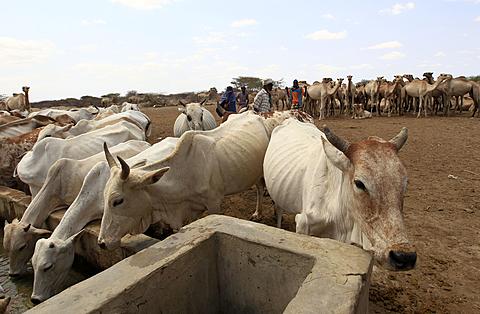 With Somalia's famine spreading, experts are looking at new strategies to address the crisis that go beyond simply feeding people.
With Somalia's famine spreading, experts are looking at new strategies to address the crisis that go beyond simply feeding people.
The town of Dobley sits just 18 kilometers from the Kenyan town of Liboi, and just three kilometers from the officially closed Kenya-Somalia border. The dusty desert town was controlled by Islamist insurgent group al-Shabab until early April, when - after three days of fighting - government forces with allied militias beat Shabab back, creating a buffer zone 90 kilometers to the north and 30 kilometers to the east and south.
Though Dobley is no longer on the front lines of Somalia's civil war, it has in recent months been at the front lines of the Somali famine. Dobley is often the last stop for displaced Somalis travelling to the sprawling refugee camps in Dadaab, Kenya. Families often pause in Dobley, taking a few days to recover for the final push into Kenya.
But with no permanent international humanitarian presence on the Somali side of the border, the town of about 5,000 families must do what they can to help the famished refugees.
According to local shopkeeper Abdullahi Abdisalam, this can cause problems for the local residents.
Abdisalam's business has suffered since the drought. With economic conditions in Dobley already quite dire, Abdisalam says providing help for the internally displaced Somalis has drained his already limited resources.
And while around 5,000 families live in Dobley, many thousands more in the surrounding area rely on the town for survival.
With the drought wreaking havoc on Somalia's countryside, as many as 50,000 pastoralist families rely on the town's two boreholes to water their livestock. It is these boreholes in the town center that reveal a unique truth about Somalia's farmers and the famine itself. The square containing the boreholes is the center of life in Dobley, packed with camels, cows, goats and sheep which their owners keep alive at great expense.
The cost of feeding livestock in Dobley is actually higher than the meat of the animals themselves. But Luca Alinovi of the U.N. Food and Agriculture Organization (FAO) says, to these families the animals are everything.
"In people's concept, the life of the individual is at least equal as the one of the animal, often less important," said Alinovi. "Because animals are the protection of all the family, the subclan and the clan. Individuals are just members of the clan."
The Dobley market is a testament to how important livestock is to the local population. For cattle, which cannot forage from the region's remaining shrubs, people purchase bundles of grass imported from Kismayo, nearly 200 kilometers away.
Kismayo is one of the strongholds of the al-Shabab rebels, who have banned all trade with government-controlled Dobley. As trader Mako Mahamud explains, the grass travels a circuitous route between Shabab blockades before arriving in Dobley - and the price more than doubles along the way.
But people continue to pay for the grass, because without it their livelihoods would disappear. Luca Alinovi of FAO explains how the refugee crisis in Kenya is closely linked to the livestock in Somalia.
"Slowly, slowly they lose animals," added Alinovi. "Below 50 head of livestock they start to become agro-pastoralists, [that is] they need also to do some agriculture to keep up. When they lose below the minimum breeding stock, then they basically have to [move]. And having to go means they become displaced. And then rebuilding costs 10 to 15 times more than it was costing keeping them in their own livelihoods."
When livestock perish, Somali refugees leave with absolutely nothing, giving them little reason to return home once they reach the safety of Kenya's refugee camps.
For this reason, a controversial new approach to famine relief is gaining currency within the FAO: feed animals instead of people. This of course does not mean ignoring the severely malnourished who arrive in refugee camps every day, but providing support and sustenance to livestock in Somalia so pastoralists have reason to stay.
There is food in Somalia, but rising prices coupled with the collapse of the local currency means many families simply cannot afford it, even by selling their animals. The FAO believes a kind of cash-for-work scheme could be utilized to build up famine-resistant infrastructure such as water catchments, while providing people with the resources to protect their most vital assets.
The U.N. organization is pushing for $70 million to test this new approach. If granted, the FAO could begin the program in Dobley, creating a buffer zone that would help people remain in Somalia and weather the storm.










